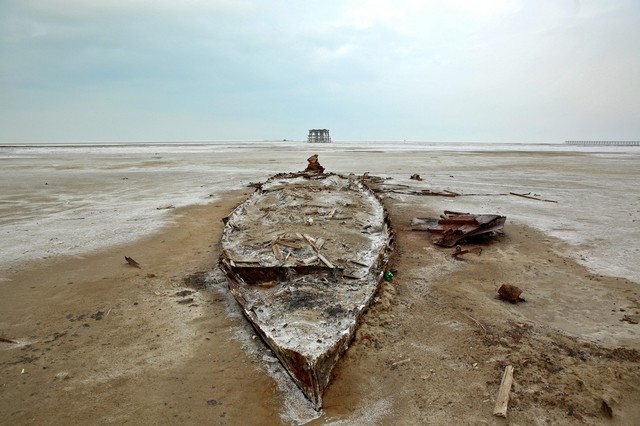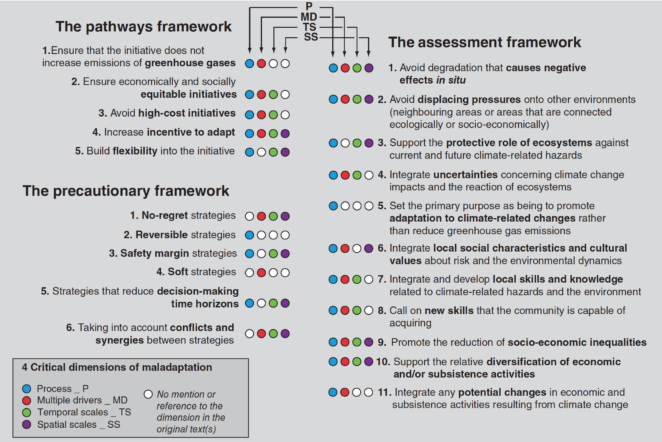Addressing the risk of maladaptation to climate change

Introduction
Efforts to support socio-ecological systems threatened by climate change are now more urgent than ever, at all scales Unfortunately not enough is currently understood about what sort of activities enhance the ability of socio-ecological and human systems to adapt long-term, and which ones have little or no impact. It has become increasingly apparent that some initiatives can actually be harmful. Some adaptations may be successful in the short term, however there is a risk that longer term the actions may affect territories’, sectors’, and people’s long-term capacity and opportunities to cope with and manage the impacts of climate change. This possibility generally describes ‘maladaptation.’
Despite increasing efforts worldwide to adapt to climate change, there appears to be little awareness about the risk of maladaptation. There is a real possibility, however, that activities done in the name of adaptation might not only waste financial resources but could also aggravate the consequences of extreme events and gradual climate-related changes. In essence, maladaptation describes an action that results in an undesirable and unintended outcome(s). This can lead to increased vulnerability, which it was meant to reduce. Interestingly, there is sometimes a very fine line between success and failure regarding adaptation, both spatially and temporally and this raises a crucial question: how can we identify possible maladaptation in reality?
A paper by Magnan et al. (2016)reviews the current theoretical scholarship on maladaptation and provides some specific case studies – in the Maldives, Ethiopia, South Africa, and Bangladesh – to advance the field by offering an improved conceptual understanding and more practice-oriented insights.
In the paper the authors highlight four main dimensions to assess the risk of maladaptation: process, multiple drivers, temporal scales and spatial scales. They also describe three examples of frameworks – the Pathways, the Precautionary, the Assessment frameworks – that can help capture the risk of maladaptation on the ground. Both these conceptual and practical developments support the need for putting the risk of maladaptation at the top of the planning agenda.
This limited-access paper “Addressing the risk of maladaptation to climate change” by Magnan et al. (2016) and published in Wiley Interdisciplinary Reviews (WIREs): Climate Change can be accessed here. This article provides an overview of what was covered in the paper.
Overview

The authors highlight four main dimensions to assess the risk of maladaptation:
- Process;
- multiple drivers;
- temporal scales; and
- spatial scales.
They also describe three examples of frameworks:the Pathways, Precautionary and Assessment frameworks – that can help capture the risk of maladaptation on the ground (see Figure 2 above). Both these conceptual and practical developments support the need for putting the risk of maladaptation at the top of the planning agenda.
The authors also present four cases to illustrate situations where maladaptation emerges, these examples are not used to decide whether we face adaptation or maladaptation, but rather to illustrate situations where maladaptation emerges and help identify critical features to describe the risk of maladaptation. Two are outlined below, but refer to the paper for full analysis:
Case Study: Hulhumalé, Maldives
Hulhumalé is an artificial island standing 2 m above current mean sea level and coastal defenses surround the majority of the island. Accordingly, Hulhumalé has been a key part of the government strategy to develop ‘ Safer islands’ to better protect people from current and future sea-related hazards— including sea-level rise, which is expected to be on the order of half a meter by 2100. The project has had major immediate detrimental effects on the surrounding reefs, especially large-scale dredging. But, as it gathered initially scattered communities in better-protected areas and, consequently, also reduced environmental pressures in many local places in the outer atolls, it is a potentially relevant response to multiple challenges, such as sea-level rise, economic development, and increased demography and environmental degradation in the outer atolls.
Case Study: Cape Town, South Africa
This case addresses the cost to coastline processes and local economy of protecting private properties located too close to the shoreline. Houses at Leisure Bay on the west coast of Cape Town were subjected to erosion of their coastal banks. Storm surges in winter were undercutting the bank and reducing the extent of garden space, with each storm event resulting in progressively worse damage. In the early 2000s, the owners’ association, funded and installed sandbags along the bank to reduce erosion. Unfortunately, this has led to numerous unintended consequences including loss of beach area, reduced recreational value, and loss of tourism and tourism-derived revenue at the bay scale. The impact on the biophysical system has also been significant as the sandbags were not ultraviolet light resistant and thus broke apart releasing strands of plastic. Even if erosion is held at bay, the presence of the sandbags has also reduced the value of the property and locked it into an undesirable state.
Lessons Learnt
The paper argues that avoiding maladaptation is a first, key step to the wider process of adapting to climate variability and change, essentially because it mainly relies on doing well what we currently do poorly. It thus advocates for starting with the intention to avoid mistakes and not lock-in detrimental effects. It calls for the anticipation of the risk of maladaptation to become a priority for decision makers and stakeholders, from the international to the local levels. Such an ex ante approach to the effectiveness of adaptation, however, assumes a clearer understanding of what maladaptation is. This paper reviews the current literature on maladaptation and provides an analysis of specific cases.
Suggested citation: Magnan, A.K., Schipper, E.L.F., Burkett, M., Bharwani, S., Burton, I., Eriksen, S., Gemenne, F., Schaar, J., Ziervogel, G., 2016. Addressing the risk of maladaptation to climate change: Addressing the risk of maladaptation to climate change. Wiley Interdisciplinary Reviews: Climate Change 7, 646–665. https://doi.org/10.1002/wcc.409
(0) Comments
There is no content